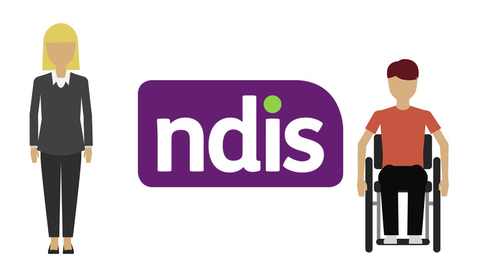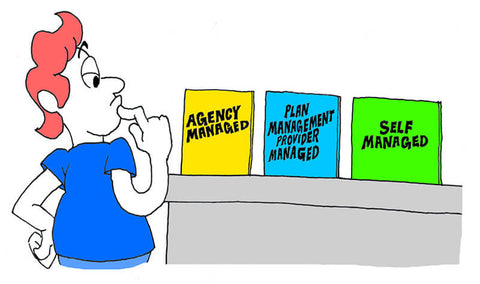There’s a lot to consider when choosing assistive technology under the NDIS. Chosen correctly, assistive technology and mobility aids help people with disabilities perform everyday tasks, reach their goals and live a happy life. But before you make a decision, you must consider your unique situation and understand the purchasing process. Let’s take a closer look at how it works…
About The NDIS

Before we explore assistive technology – let’s first take a look at the NDIS in Australia, as this will impact your purchasing process. The NDIS is the National Disability Insurance Scheme provided by the Australian Government. Its aim is to empower and support individuals living with a permanent or significant disability, as well as their families and carers.
Every NDIS participant will have a support plan, which is tailored to meet their individual goals. This could be anything from landing a job, getting involved in the community or receiving mobility aids. The NDIS is managed by the National Disability Insurance Agency (NDIA) – which exists to ensure individuals are getting the support they deserve. The NDIS is jointly funded by the Australian and state governments.
What Is Assistive Technology?

If you’re an NDIS participant, you may be eligible for funding for assistive technology (AT) products. Put simply, assistive technology is a device or system that improves an individual’s ability to perform tasks safely and easily. It helps an individual reach their full potential – whether that is at home, in the community or the workplace.
Assistive technology comes in all shapes and sizes – from non-slip bath mats to hearing aids to portable mobility ramps. To find the right solution, assistive technology is sorted into 4 different levels based on their complexity.
Complexity Levels Of Assistive Technology Products
Everyone’s needs are different – and that’s why your NDIS support plan is tailored to you. When using your NDIS funds to buy assistive technology, you may or may not require an assessment. As a general rule, assessments are required for more complex and customised products. Assistive technology is sorted into 4 levels:
Level One
These are simple, low cost and low-risk products. They can often be bought from your local store, such as a non-slip bathmat, walking stick or doorbell. These products don’t require an assessment before you access your funds.
Level Two
These are considered “off-the-shelf” products that you can buy from a specialised supplier (they don’t need to be customised). Level two products are often subject to testing and trialling before they are available, including items like shower stools, handrails and portable ramps. Assessment may be required before you access your funds.
Level Three
This category is similar to level two; however, these items need to be tailored to suit your individual needs. This includes items such as pressure mattresses, bath lifts and power-assisted wheelchairs. You can buy these from specialised suppliers, but before you begin you will need to undergo an assessment before you can access your funds.
Level Four
This category includes custom made or tailored products, and you will need to work alongside an assistive technology assessor. Examples include complex home modifications, prosthetics, communication devices, power wheelchairs and more.
Please note, this is not a comprehensive list, and for specialist advice it’s best to refer to the NDIS website.
How Do I Get Funding For Assistive Technology?

There are different options for managing your NDIS plan, and this will affect how you get funding for your assistive technology and mobility aids. Let’s look at your options…
Self-Managed
In a self-managed support plan, you have complete control over where you buy your assistive technology. You can negotiate directly with a supplier – which may mean you’ll get the best price. You can also use registered or unregistered providers – it’s entirely up to you.
NDIA-Managed
This is when you work directly with a support coordinator or a local area coordinator (LAC), which is funded by your plan. Your LAC or support coordinator can help to connect you with the best providers for your needs. If you are NDIA-managed, you cannot use unregistered providers for your assistive technology.
Plan Managed
You can also elect to use a registered Plan Manager. Your Plan Manager will help you to access registered and non-registered providers – and you will have some choice over the providers. The main difference between a plan manager and a support coordinator is that your Plan Manager can assist with the financial side of things – whereas a support coordinator only manages your providers.
A Combination
Lastly, some individuals choose to use a combination of the above.
Should I Use Registered Or Unregistered Providers For Assistive Technology?

It’s entirely up to you if you use registered or unregistered providers. Don’t let the term unregistered deter you - there are plenty of highly skilled, specialised and dedicated providers out there that are not registered with NDIS. You see, the registration process takes time, money and effort – which can be a roadblock for a lot of small businesses.
Many NDIS participants have positive experiences with unregistered providers. But keep in mind that you can only use unregistered providers if your NDIS plan is self-managed or plan managed. If your plan is NDIA managed you cannot use unregistered providers, which can restrict your options.
Do You Want To Use Your NDIS Funding For Wheelchair Ramps?
Here at Ramp Champ, we offer some of the world’s best mobility ramps for scooters, wheelchairs, rollators, walkers and pedestrians. Whether you need a portable ramp, a vehicle ramp or a custom made rubber door ramp – we’ll help to make your life easier and boost your independence. We can customise our ramps to suit your needs – such as capacity, length, materials and type. No job is too big or small.
At Ramp Champ, we’re unregistered providers – which means we work directly with individuals in a self-managed or plan managed NDIS plan. If you purchase a wheelchair or mobility ramp with us on a self-managed plan, you can claim your funds back from NDIS. If you’re plan managed, your plan manager will do this for you.
Ramp Champ Is Here To Help!
Do you need help finding the right mobility ramp? Ramp Champ has got you covered. Visit our website to find the right ramp in 30 seconds. We’re here to help you get the care and equipment you need – so you can get back to living life on your terms.
Shop Wheelchair & Mobility Ramps






2 comments
Hi Alice,
We have a wide variety of threshold ramps, from rubber, aluminium, plastic, and steel. Depending on the height of where it will be used, we can make recommendations to you for a ramp that’s not rubber. Please send an email to hello@rampchamp.com.au with details of the application and one of our sales experts will assist you.
DO YOU HAVE THRESHOLD RAMPS MADE OF OTHER MATERIAL THAN RUBBER? RUBBER CONTAINS LATEX AND THE PERSON HAS A SEVERE ALLERGY. JUST TRYING TO SEE WHAT ELSE IS BEING USED. THANK YOU. SORRY FOR CAPS. CAN NOT SEE WELL.